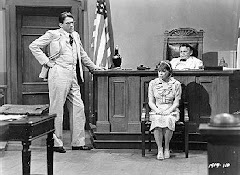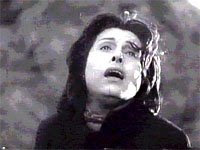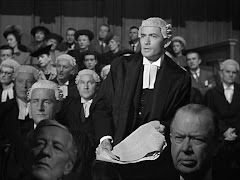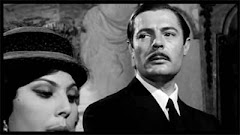- Try to find some significant examples of the different textual approches to ‘law and film’ and analyse their various purposes and consequences: the instituzionalization of a new interdisciplinary scholarship, the usefulness of films as a pedagogical tool (within the American Law Schools), or the so-called ‘postmodern challenge’ (Richard Sherwin, When Law goes Pop, University of Chicago Press, 2000).
- Try to find some juridical debate raised by the distribution of an entertainment product (movies, computer games, TV shows, songs) and constitutional and legal restraints to freedom of speech (as we did with The Miracle decision).
Law and the Humanities at Roma Tre
The blog of the "Law and the Humanities" course of lessons at the Roma Tre University (Law Faculty)
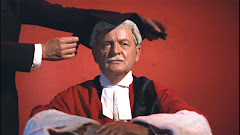
Alfred Hitchock's "Dial M for Murder" (1954)
Monday 9 June 2008
Last but not Least: Prof. Conde Questions
Saturday 7 June 2008
Last questions!!!
Dear all,
here, finally, the last questions of the L&H course of lessons. Good luck!
Prof. Resta:
1) "What are the similarities and differences between legal and musical interpretation?"
2) "How is the law/music analogy employed by Betti and Frank?"
Prof. Ascheri:
"Explain why it is possibile to say that the Sienese 'Buongoverno'frescho could be considered the most important 'reading' of the urbanItalian society of the Late Middle Ages".
Prof. Zeno-Zencovich:
How is it being a US law student? Try to see these two movies, compare them, and then analyse your experience as a law student
The Paper Chase (James Bridges, 1973)
Legally Blonde (Robert Luketic, 2001)
here, finally, the last questions of the L&H course of lessons. Good luck!
Prof. Resta:
1) "What are the similarities and differences between legal and musical interpretation?"
2) "How is the law/music analogy employed by Betti and Frank?"
Prof. Ascheri:
"Explain why it is possibile to say that the Sienese 'Buongoverno'frescho could be considered the most important 'reading' of the urbanItalian society of the Late Middle Ages".
Prof. Zeno-Zencovich:
How is it being a US law student? Try to see these two movies, compare them, and then analyse your experience as a law student
The Paper Chase (James Bridges, 1973)
Legally Blonde (Robert Luketic, 2001)
Prof. Vano:
1. Chaplin world view as an introduction to the main questions of the history of labour law: Did you find it appropriate or useful in any way?
2. American labour relations at the beginning of the XX century: the analisys of Max Weber. What do you think of the european perspectives?
Sunday 25 May 2008
What do you think of the Law and the Humanities Course of Lessons?
Dear students,
Prof. Conte and I would be really happy to know what do you think about the Law and the Humanities course of lessons that we experimented this year. Which lessons did you enjoy the most? What would you suggest to change? Did anything disappoint you? Someone already told me his/her ideas for a similar course next year but it would be useful to repete them on the blog. You can just leave a comment: feel free to express your opinions.
Thank you for having accepted the challenge of this new course of lessons!
Best
Stefania Gialdroni
Prof. Conte and I would be really happy to know what do you think about the Law and the Humanities course of lessons that we experimented this year. Which lessons did you enjoy the most? What would you suggest to change? Did anything disappoint you? Someone already told me his/her ideas for a similar course next year but it would be useful to repete them on the blog. You can just leave a comment: feel free to express your opinions.
Thank you for having accepted the challenge of this new course of lessons!
Best
Stefania Gialdroni
Thursday 22 May 2008
Last Lecture
Dear students,
Prof. Kiesow's lesson will take place on Wednesday the 28th of May from 12:00 a.m to 13:30 a.m. in the room number 9.
Best
Prof. Kiesow's lesson will take place on Wednesday the 28th of May from 12:00 a.m to 13:30 a.m. in the room number 9.
Best
Prof. Vano's Lectures: Law and Cinema
Dear all,
here some information about Prof. Vano's lessons, readings and C.V.. We are finally arrived at the end of our Law and the Humanities course of lessons, but don't forget the important, conclusive lesson by Prof. Kiesow on May the 28th. Probably the lesson will take place a little bit earlier, at 12:00, but it is very important that you will be there. So...don't forget to have a look at the blog!
Abstract:
Roma tre, May 21-23, 2008
Law & Cinema. Chaplin’s Modern Times: a “deep sense of unlawfullness”
May 21, 2008
Film screening
Modern Times (1936)
Directed by Ch. Chaplin
Short Introduction: The Universe of industrial Labour, Cinema and Legal History
May 22 -23, 2008
Discussion about the movie and selection of the principle themes of legal historical relevance.
From Europe to America and Back to Europe.
Chaplin and the American working class
Observations upon Max Weber’s view of the American labour relations
Readings:
Steven J. Ross, Struggles for the screen: Workers, Radicals, and the political Uses of Silent Film, in The American Historical Review, vol. 96, n. 2 (1991), pp.333-367
Carlo Nitsch, Prospettive dalla riflessione weberiana sulle condizioni di lavoro negli Stati Uniti, in Materiali per una storia della cultura giuridica moderna, 2007 /2, pp.337 ss.
C.V.:
Cristina Vano
Associate Professor, since 2002, of Medieval and Modern Legal History at the Law Faculty of the University of Naples "Federico II". Member of the academic committee of the Research Doctorate in “Roman Law and Roman Law Tradition: the foundations of European law”. Member of the editorial board of the journal “Scienza & politica” (1993-2006) and of "Index. International Survey of Roman Law",(since 2001). She spent long periods of research in Italian and foreign Research Institutes such as: the Istituto storico italo-germanico in Trento (1986), University of Berlin (1987, 1990), University of Trier (1991-1992), the Institut für Römisches und gemeines Recht di Göttingen (1994), the University of California at Berkeley, Robbins Collection, (1996) and above all at the Max Planck Institut für Europäische Rechtsgeschichte in Frankfurt am Main. Member of several international research groups, she taught courses and delivered conferences in many Universities in Italy and abroad (Germany, Switzerland, Spain, Sweden, Portugal). Her research focuses on Savigny and the Historical School with special regard to the construction processes of European nineteenth century legal science and to the communication strategies of scientific knowledge. Her book Il nostro autentico Gaio. Strategie della scuola storica alle origini della romanistica moderna (Napoli 2000) has been recently translated into german (Frankfurt 2008). Moreover she is interested in the history of Italian and European juridical culture of the XIX and XX century, with particular attention for such themes as the use of comparative methods, the professionalization of the jurist, the history of Labour Law.
here some information about Prof. Vano's lessons, readings and C.V.. We are finally arrived at the end of our Law and the Humanities course of lessons, but don't forget the important, conclusive lesson by Prof. Kiesow on May the 28th. Probably the lesson will take place a little bit earlier, at 12:00, but it is very important that you will be there. So...don't forget to have a look at the blog!
Abstract:
Roma tre, May 21-23, 2008
Law & Cinema. Chaplin’s Modern Times: a “deep sense of unlawfullness”
May 21, 2008
Film screening
Modern Times (1936)
Directed by Ch. Chaplin
Short Introduction: The Universe of industrial Labour, Cinema and Legal History
May 22 -23, 2008
Discussion about the movie and selection of the principle themes of legal historical relevance.
From Europe to America and Back to Europe.
Chaplin and the American working class
Observations upon Max Weber’s view of the American labour relations
Readings:
Steven J. Ross, Struggles for the screen: Workers, Radicals, and the political Uses of Silent Film, in The American Historical Review, vol. 96, n. 2 (1991), pp.333-367
Carlo Nitsch, Prospettive dalla riflessione weberiana sulle condizioni di lavoro negli Stati Uniti, in Materiali per una storia della cultura giuridica moderna, 2007 /2, pp.337 ss.
C.V.:
Cristina Vano
Associate Professor, since 2002, of Medieval and Modern Legal History at the Law Faculty of the University of Naples "Federico II". Member of the academic committee of the Research Doctorate in “Roman Law and Roman Law Tradition: the foundations of European law”. Member of the editorial board of the journal “Scienza & politica” (1993-2006) and of "Index. International Survey of Roman Law",(since 2001). She spent long periods of research in Italian and foreign Research Institutes such as: the Istituto storico italo-germanico in Trento (1986), University of Berlin (1987, 1990), University of Trier (1991-1992), the Institut für Römisches und gemeines Recht di Göttingen (1994), the University of California at Berkeley, Robbins Collection, (1996) and above all at the Max Planck Institut für Europäische Rechtsgeschichte in Frankfurt am Main. Member of several international research groups, she taught courses and delivered conferences in many Universities in Italy and abroad (Germany, Switzerland, Spain, Sweden, Portugal). Her research focuses on Savigny and the Historical School with special regard to the construction processes of European nineteenth century legal science and to the communication strategies of scientific knowledge. Her book Il nostro autentico Gaio. Strategie della scuola storica alle origini della romanistica moderna (Napoli 2000) has been recently translated into german (Frankfurt 2008). Moreover she is interested in the history of Italian and European juridical culture of the XIX and XX century, with particular attention for such themes as the use of comparative methods, the professionalization of the jurist, the history of Labour Law.
Thursday 15 May 2008
Prof. Conde's Lectures: Law and Cinema
Dear all,
with a little bit of delay, finally on the blog all the information about Prof. Conde's lectures, readings and c.v.
Abstract:
The lectures will introduce the ‘law and cinema’ contemporary scholarship, trying to look critically (from a european perspective) at some of its premises and results.
Therefore we will focus on underline one of the possible intersections between law and films: that of ‘cinema in law’ (or law on cinema). This approach is by far much less attended (and maybe less ‘funny’, more ‘serious’) than the classical ‘law in cinema’ studies or the (amusing and even ‘worrying’) ‘law as cinema/cinema as law’ debates.
More specifically we will tackle some US Supreme Court decisions (and indecisions) to concisely describe the way in which censorship on films has been –constitutionally and legally- formulated in the twentieth century.
The account should serve as an example –and encouragement- for those students interested in the development of similar subjects, which are not necessarily involved with totalitarian regimes or tendencies.And above all, it is a proposal –and a provocation- concerning the unavoidable (self)analysis about the (individual, social, juridical, economical) limits and burdens of freedom of speech.
Readings:
A) The Yale Law Journal, Vol. 98, No.8, “Popular Legal Culture” (June 1989) (“Introduction”, pp. 1545-1558; Lawrence M. Friedman, “Law, Lawyers, and Popular Culture”, pp. 1579-1606)
C.V.
with a little bit of delay, finally on the blog all the information about Prof. Conde's lectures, readings and c.v.
Abstract:
The lectures will introduce the ‘law and cinema’ contemporary scholarship, trying to look critically (from a european perspective) at some of its premises and results.
Therefore we will focus on underline one of the possible intersections between law and films: that of ‘cinema in law’ (or law on cinema). This approach is by far much less attended (and maybe less ‘funny’, more ‘serious’) than the classical ‘law in cinema’ studies or the (amusing and even ‘worrying’) ‘law as cinema/cinema as law’ debates.
More specifically we will tackle some US Supreme Court decisions (and indecisions) to concisely describe the way in which censorship on films has been –constitutionally and legally- formulated in the twentieth century.
The account should serve as an example –and encouragement- for those students interested in the development of similar subjects, which are not necessarily involved with totalitarian regimes or tendencies.And above all, it is a proposal –and a provocation- concerning the unavoidable (self)analysis about the (individual, social, juridical, economical) limits and burdens of freedom of speech.
Readings:
A) The Yale Law Journal, Vol. 98, No.8, “Popular Legal Culture” (June 1989) (“Introduction”, pp. 1545-1558; Lawrence M. Friedman, “Law, Lawyers, and Popular Culture”, pp. 1579-1606)
Stefan Machura/Peter Robson (eds.), Journal of Law and Society, Vol. 28, No. 1, “Law and Film” (March 2001). The “Introduction”, pp.1-8, includes a selected bibliography (1986-1999)
B) “Motion Pictures and the First Amendment”, The Yale Law Journal, Vol. 60, No. 4. (April 1951), pp. 696-719.
C.V.
Esteban Conde (Barcelona, 1971), Legal Historian (Universities of Barcelona –Autónoma- and now Huelva), received his Ph.D. in Law in 2003. He has written two books (1998, 2006) about the main (and constructive) role played by ‘enlightened’ censorship in Spain, and several articles on police power (its metaphores, tradition and development at the end of the Ancien Régime).
Over the past five years, he has used some interdisciplinary approaches as a tool to teach legal history: litterature and law, and more recently cinema and law.Pictures Law and Music
Subscribe to:
Posts (Atom)






